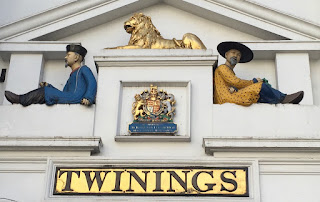Lloyds Bank Law Courts Branch; Twinings, Tweed, an unexpected part 2
In my last post I wrote a little of the beginnings of Twinings Tea Merchants their bank and the link with my family tree.
Last week I happened to walk past Lloyds on the Strand and popped in to take a closer look.
Twinings bank was first established to offer a selection of financial facilities to family and friends. Initially part of the thriving tea company it soon became successful enough to become a separate business in its own right.
In 1824 the lone clerk, sat at his high desk squeezed alongside the safe in his tiny office. Delicious aromas of tea and coffee wafted through the door from Devereux Court as he exchanged cheques for cash, weighing out expensive fine tea or coffee as part of the deal if required.
Soon many merchants from outside the family circle were using the expanding bank. New, larger premises were required and the Twining’s built a new establishment beside their tea shop on the Strand in 1835, a very suitable arrangement as their tea trade supported the bank safely through several national financial crises.
As the 19th century progressed many smaller banks combined and swelled their coffers to cover ever larger areas. In 1892 Lloyds put in an offer to take over Twining’s Bank. At the time Richard Twining And Co consisted of six partners, each being listed as ‘Banker and Tea Man’* with Arthur James Tweed and Charles Twining Sidgwick both living at the bank’s address, 215 Strand.
Across the road from Twining’s and the bank, the Royal Courts of Justice long rebuild was completed in 1882. Bigger and grander than its ancient predecessor, it was felt that a new restaurant was needed to match it’s splendour. The chosen spot was at 222-225, where the once famous Palsgrave Head Tavern had stood.
The splendidly titled architects Wimble and Cuthbert created a magnificent outer lobby using Royal Doulton ware, majolica style ceramics and intricate arabesque mosaics. Through the doors the interior lobby is richly decorated and wood clad. John McLennan designed images for large conjoined Doulton tiles, including Ben Johnson characters, fashionable golden chrysanthemum types from the nearby Temple Gardens, and Frederick Palsgrave (husband of Elizabeth Stuart, Queen of Bohemia) reflecting the history of the previous tavern.
The restaurant failed to attract its target audience of barristers, judges and upper class clients from the Royal Courts of Justice despite the obvious draw of a ventilation system powered by two women on a tandem!The business failed twice and Lloyds took over the building in 1895. Richard Twining became a director at Lloyds and retired two years later at the grand age of 90.
The branch is due to close in August, if you are passing it’s well worth a visit to admire its sumptuous interior, who knows what it’s future holds?
*Supplement to the London Gazette, Feb 1892
Information display inside the branch at 222-5 Strand.
http://www.lloydsbankinggroup.com/Our-Group/our-heritage/2015-our-milestone-year/250-years-of-lloyds-bank/branch-stories/law-courts-london/
http://tilesoc.org.uk/tile-gazetteer/westminster.html
http://londonist.com/2016/09/is-this-london-s-most-beautiful-bank
https://www.innertemple.org.uk/index/the-inner-temple-garden?showall=&start=1
http://chestofbooks.com/gardening-horticulture/Gardener-1/index.html











